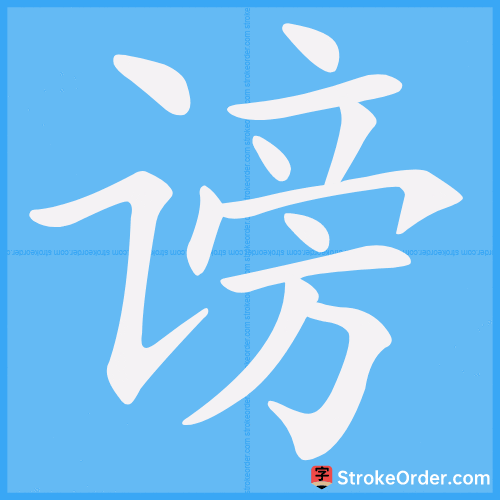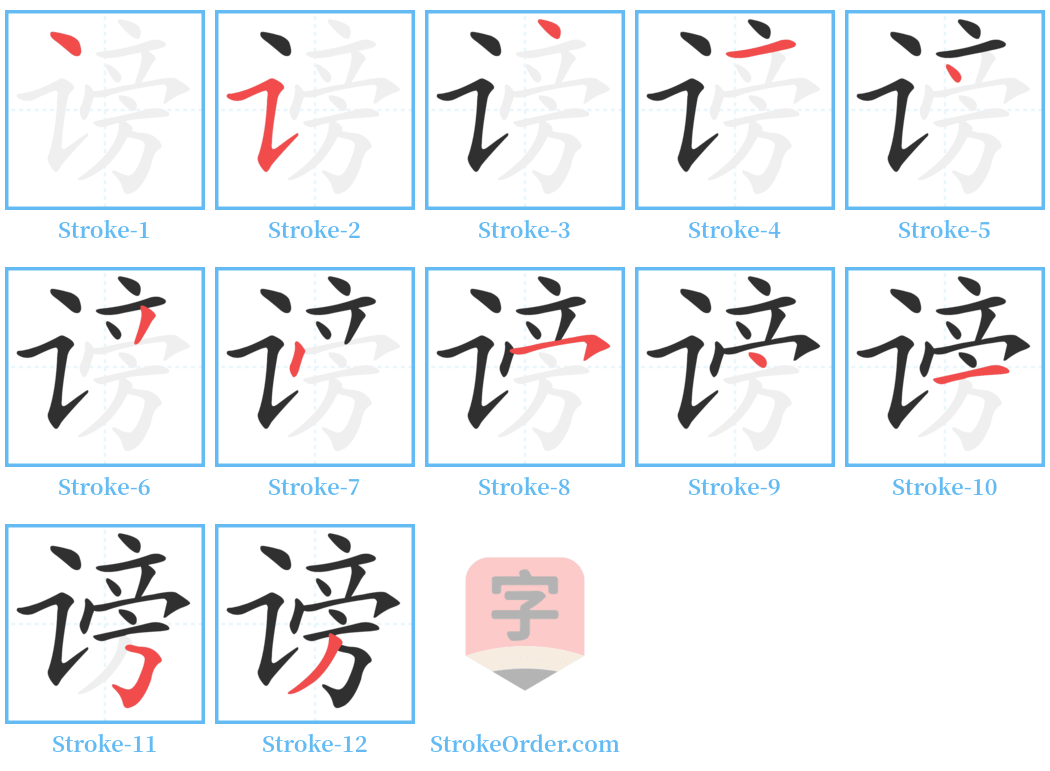谤 Stroke Order
Animated Stroke Order of 谤

Stroke Order Diagrams for 谤

Step-by-Step Handwriting Guide for 谤

Learn to Write Chinese Characters with Video Tutorials
Watch the video of writing the Chinese character "谤", learn the correct stroke order (笔顺) of the character "谤", and master the standard way of writing the character "谤".
Free Printable Handwriting Practice with Stroke Order: 谤
Printable Writing Practice Worksheet of "谤" in Portrait Orientation (Tian Zi Ge)

Printable Writing Practice Worksheet of "谤" in Landscape Orientation (Tian Zi Ge)

Information of 谤
Pinyin
bàng
Radical
讠
Strokes
12 strokes
Usage
★★★★★
Definition
to slander / defame / speak ill of
谤
bàng
动
【本义】: 在背后公开地议论或批评某人的短处
[En.] The original meaning: To openly discuss or criticize someone's shortcomings behind their back.
【造字法】: 形声兼会意。从言,旁声。
[En.] Character formation: A combination of phonetic and ideographic elements. Consists of the radical for speech and a phonetic component.
【释义】
1. 同本义 ([En.] criticise openly)
引: 《说文》:谤,毁也。按,谤者道人之实,事与诬谮不同。大言曰谤,小言曰诽,曰讥。
[En.] "Shuowen": 'Bàng' means to slander. A 'bàng' is different from a libel; a 'bàng' openly discusses the truth. 'Bàng' refers to grand statements, while 'fěi' refers to smaller statements or slanders.
例: 谤书 (攻击别人或揭发别人隐私的文书; 亦专指《史记》)
[En.] Example: "Bàngshu" (Documents attacking others or exposing their privacy; also specifically refers to "Records of the Grand Historian").
2. 诽谤 ([En.] defame; slander)
引:《史记·屈原贾生列传》:信而见疑,忠而被谤,能无怨乎?
[En.] "Records of the Grand Historian": When one is trusted but doubted, loyal but slandered, how can one not feel wronged?
例: 谤言 (公开指责他人的话。同谤议); 谤誉 (毁谤或赞誉)
[En.] Example: "Bàngyán" (Public accusations against others; synonymous with bàngyì); "Bàngyù" (Slander or praise).
3. 诅咒 ([En.] curse)
引: 《左传·昭公二十七年》:进胙者莫不谤令尹。
[En.] "Zuo Zhuan": No one who presented a sacrifice did not curse the chancellor.
Input Method for 谤
Pinyin
bang4
Wubi
yupy|yyuy
Cangjie
ivybs
Zhengma
ssws
Four Corner
30727
Unicode
U+8c24
Same Pronunciation Characters